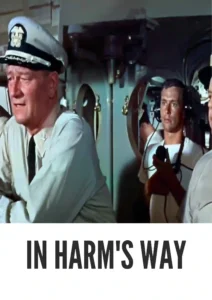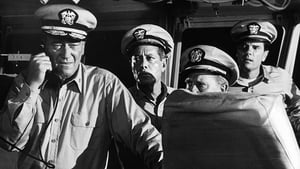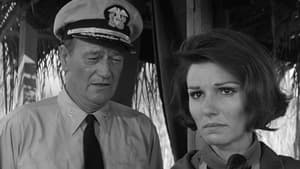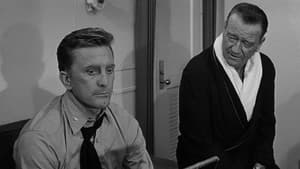Contact: info@alwanfilm.com
Video Sources 0 Views

Synopsis
Review: In Harm’s Way 1965 Colorized – A War Epic Revisited

Introduction
“In Harm’s Way,” a 1965 cinematic epic directed by Otto Preminger, remains one of the most significant war films of its era. Starring Hollywood legends John Wayne and Kirk Douglas, the film explores the grim realities of World War II, blending personal drama with large-scale military operations. While many war films of the 1960s leaned heavily on action and spectacle, In Harm’s Way distinguishes itself through its exploration of complex human emotions and the personal cost of war. This article delves into the film’s story, cast, and impact, while also addressing the critical reception and legacy of this quintessential American war drama.
Check The Full Colorized Movies List
Check Our Colorized Movies Trailer Channel
Understanding In Harm’s Way 1965 Colorized: Director, Cast, and Genre
“In Harm’s Way” is a product of Otto Preminger’s distinctive directorial style. Preminger, known for his bold thematic choices and unflinching portrayal of controversial subjects, approached this World War II epic with a blend of grit and grandeur. His direction ensured that In Harm’s Way was not just another war movie but a nuanced narrative exploring the darker, often overlooked aspects of military life.
The film’s cast is a veritable who’s who of classic Hollywood. John Wayne, as the stoic and battle-hardened Captain Rockwell “Rock” Torrey, brings his signature blend of toughness and understated vulnerability. Wayne’s performance is complemented by the intense and emotionally charged portrayal of Commander Paul Eddington by Kirk Douglas. Eddington’s character, grappling with inner demons and moral ambiguities, provides a counterpoint to Torrey’s steady resolve.
The supporting cast is equally impressive, featuring Patricia Neal as Maggie Haynes, a Navy nurse who becomes romantically involved with Torrey. Neal’s portrayal of Maggie adds depth and humanity to the story, grounding the film’s grander themes in intimate personal relationships. Other notable performances include Tom Tryon as Captain Thomas “Tom” Torrey, Jr., and Henry Fonda in a brief but memorable role as Admiral Chester Nimitz.
As a war film, In Harm’s Way occupies a unique space within the genre. It combines the epic scale and patriotic fervor typical of war movies with a more introspective, character-driven narrative. This duality allows the film to explore not only the strategies and tactics of naval warfare but also the psychological and emotional toll on those who serve.
Exploring the World of In Harm’s Way 1965 Colorized: Plot and Characters
The plot of In Harm’s Way unfolds against the backdrop of the Pacific Theater during World War II, beginning with the infamous attack on Pearl Harbor. The film follows Captain Rockwell Torrey, who, after the devastating surprise attack, is assigned to lead a counteroffensive against the Japanese forces. Torrey, having been sidelined after a controversial decision early in the war, must navigate both the military challenges and the complex personal relationships that arise in the high-stakes environment of war.
One of the film’s most compelling elements is its focus on the personal lives of its characters amidst the chaos of war. Torrey’s romance with Maggie Haynes is portrayed with sensitivity and realism, offering a poignant contrast to the brutality of combat. Their relationship evolves naturally, driven by shared experiences and mutual respect, rather than the melodramatic tropes often found in war films.
Commander Paul Eddington, played by Kirk Douglas, is another central figure whose story arc adds depth to the film. Eddington is a man haunted by past mistakes and personal failings, struggling to maintain his composure and sense of duty. His journey from a reckless officer to a man seeking redemption is one of the most emotionally resonant aspects of the film.
The film also explores the generational conflict between Captain Torrey and his son, Lieutenant (junior grade) Thomas “Tom” Torrey, Jr., played by Tom Tryon. Their strained relationship reflects the broader theme of the sacrifices made by those in the military, both in their personal lives and on the battlefield. This subplot adds another layer of complexity to the narrative, illustrating the human cost of war beyond the immediate dangers of combat.
The Art of Film Colorization
Film colorization, particularly in the mid-20th century, was an emerging art form that sought to enhance the visual appeal of movies originally shot in black and white or with a limited color palette. Although In Harm’s Way was filmed in black and white, a stylistic choice that reinforced its serious tone and stark depiction of war, the advent of colorization technology later brought new dimensions to the film.
Colorization, when applied to films like In Harm’s Way, can alter the mood and impact of the original cinematography. The process involves digitally adding color to black and white footage, using historical references and artistic interpretation to create a natural-looking color palette. While some purists argue that colorization detracts from the original vision of the filmmakers, others appreciate the added visual depth and modern accessibility it can provide.
Early Colored Films: A Brief History
The transition from black and white to color in cinema was a gradual process, marked by both technological innovation and artistic experimentation. Early color films, such as “The Adventures of Robin Hood” (1938) and “Gone with the Wind” (1939), showcased the potential of Technicolor, a process that used multiple strips of film to capture vivid, realistic hues.
Despite the success of these early color films, black and white remained the dominant format for many years, particularly for dramas and war films, where the absence of color was often used to convey a sense of realism or gravitas. The choice to film In Harm’s Way in black and white was likely influenced by this tradition, as well as by the desire to evoke the documentary-style footage that audiences associated with World War II newsreels.
In Harm’s Way and Its Early Colored Version
While In Harm’s Way was originally released in black and white, reflecting the somber tone of the narrative, later versions of the film have been colorized, offering a different viewing experience. The decision to release a colorized version of the film reflects ongoing debates within the industry about the role of color in storytelling and the preservation of classic films.
The colorization of In Harm’s Way presents the film in a new light, literally and figuratively. The vivid hues of the Pacific islands, the blue of the naval uniforms, and the contrast between the sunlit exteriors and the shadowy interiors all take on a new dimension in the colorized version. For some viewers, these added visual elements enhance the film’s emotional impact and bring the historical setting to life. However, for others, the colorized version may detract from the film’s original starkness, which was a deliberate choice to underline the gravity of the subject matter.
The Debate Over Film Colorization
The debate over film colorization is one that has persisted for decades. Proponents argue that colorization makes older films more accessible to contemporary audiences, particularly younger viewers who may be less accustomed to black and white movies. They also point out that colorization can enhance the visual storytelling of a film, drawing attention to details that might be overlooked in a monochrome format.
On the other hand, critics of colorization contend that it can compromise the artistic integrity of a film. Directors and cinematographers often choose black and white for specific aesthetic or thematic reasons, and adding color can alter the tone and mood of the original work. Moreover, there is a concern that colorization may overshadow the historical significance of black and white films, which were products of their time and should be preserved in their original form.
For In Harm’s Way, the colorization debate touches on these broader issues. While the colorized version offers a fresh perspective on the film, it also raises questions about how we preserve and interpret classic cinema. Is it enough to present a film in its original form, or should we embrace new technologies that allow us to experience these stories in different ways?
Examining In Harm’s Way as an Early Colored Film
As an early colorized film, In Harm’s Way provides a case study in how color can change the way we perceive and understand a story. The film’s epic naval battles, which are grand and visually striking in black and white, take on a new level of intensity in the colorized version. The ocean’s blue expanse, the fiery explosions, and the red and white stripes of the American flag all become more pronounced, adding a layer of visual drama to the action scenes.
However, colorization also affects the film’s quieter, more introspective moments. The somber grayscale of the original highlights the emotional weight of the characters’ personal struggles and the grim reality of war. In color, these scenes may lose some of their starkness and immediacy, as the added hues can soften the visual impact and shift the viewer’s focus from the characters’ internal conflicts to their external surroundings.
The colorized version of In Harm’s Way thus invites viewers to reconsider the film from a different perspective, appreciating the added visual details while also reflecting on what might be lost in the transition from black and white to color.
Influence and Legacy: In Harm’s Way 1965 Colorized’s Impact on Cinema
In Harm’s Way has left a lasting legacy in the war film genre, influencing subsequent depictions of World War II and military life. The film’s combination of personal drama and large-scale action set pieces paved the way for later war epics, such as “The Dirty Dozen” (1967) and “Tora! Tora! Tora!” (1970).
The film also reinforced the status of its leading actors, particularly John Wayne, as icons of American cinema. Wayne’s portrayal of Captain Rockwell Torrey exemplified the stoic, heroic figure that became synonymous with his career, while Kirk Douglas’s more nuanced performance as Commander Paul Eddington showcased the emotional complexity that war can engender.
The influence of In Harm’s Way can also be seen in the way later films approached the themes of honor, sacrifice, and the moral ambiguities of war. By focusing on the personal lives of its characters as well as their military duties, the film set a precedent for more character-driven war dramas, a tradition that continues in contemporary cinema.
Director’s Cinematic Legacy: Beyond In Harm’s Way 1965 Colorized
Otto Preminger’s work on In Harm’s Way is just one chapter in a distinguished career that spanned multiple genres and decades. Known for pushing boundaries and challenging Hollywood norms, Preminger was a director who refused to be pigeonholed, tackling everything from film noir to courtroom dramas with equal skill and ambition.
Before In Harm’s Way, Preminger was perhaps best known for his work on Laura (1944) and Anatomy of a Murder (1959), films that demonstrated his mastery of suspense and character development. His ability to draw compelling performances from his actors and his willingness to confront controversial subjects made him a distinctive voice in mid-20th century cinema.
After In Harm’s Way, Preminger continued to explore complex social issues in films like Advise & Consent (1962), a political drama that delved into the machinations of Washington, D.C., and Hurry Sundown (1967), which addressed racial tensions in the American South. His legacy as a filmmaker is defined by his commitment to challenging audiences and expanding the scope of what cinema could address.
Themes Explored in In Harm’s Way 1965 Colorized
In Harm’s Way is rich in themes that resonate beyond the context of World War II. The film explores the nature of duty and leadership, examining how individuals navigate the demands of war while grappling with their personal flaws and responsibilities. The characters’ struggles with guilt, redemption, and the pursuit of honor reflect broader questions about the human condition, making the film relevant even today.
The theme of sacrifice is central to the film, as characters must make difficult choices that often have devastating consequences. Whether it’s Torrey’s decision to prioritize a risky military strategy or Eddington’s quest for redemption through reckless bravery, the film highlights the high stakes of war and the personal costs involved.
Another prominent theme is the moral ambiguity of war. In Harm’s Way does not present a black-and-white view of heroism; instead, it acknowledges the complexities and contradictions inherent in wartime decisions. The film’s characters are flawed and human, struggling with their own imperfections even as they strive to fulfill their duties.
Reception and Controversy Surrounding In Harm’s Way 1965 Colorized
Upon its release, In Harm’s Way received a mixed reception from critics, with some praising its ambitious scope and star-studded cast, while others criticized it for being overly long and melodramatic. However, the film has since gained a more favorable reputation, particularly for its performances and its realistic portrayal of the complexities of military life.
The colorized version of In Harm’s Way has sparked its own share of controversy, particularly among film purists who argue that the original black and white format is integral to the film’s tone and message. Despite these concerns, the colorized version has found an audience among those who appreciate the added visual dimension and accessibility it provides.
Where to Watch In Harm’s Way 1965 Colorized Online
For those interested in watching In Harm’s Way, the film is available on various streaming platforms, including Amazon Prime Video, Apple TV, and Google Play Movies. Both the original black and white version and the colorized version can be found, allowing viewers to choose how they want to experience this classic war film.
FAQs About In Harm’s Way 1965 Colorized
Q: Is In Harm’s Way based on a true story?
A: While In Harm’s Way is a work of fiction, it is loosely based on actual events and experiences from World War II, particularly in the Pacific Theater. The film’s depiction of naval warfare and military strategies is informed by real-life battles and military operations.
Q: Why was the film shot in black and white?
A: The decision to shoot In Harm’s Way in black and white was likely influenced by the desire to evoke the documentary-style footage of World War II and to underscore the seriousness of the film’s themes. The stark contrasts of black and white also help to highlight the emotional and moral complexities of the characters.
Q: How does the colorized version differ from the original?
A: The colorized version of In Harm’s Way adds a new visual dimension to the film, using digital technology to apply color to the original black and white footage. This version can enhance certain aspects of the film, such as the visual impact of the naval battles, but it may also alter the tone and mood that the black and white format was intended to convey.
Conclusion
In Harm’s Way (1965) stands as a monumental achievement in the war film genre, combining epic naval battles with intimate character studies to create a powerful and enduring narrative. Whether viewed in its original black and white or its colorized version, the film offers a compelling exploration of duty, sacrifice, and the moral ambiguities of war.
Otto Preminger’s direction, combined with standout performances from John Wayne, Kirk Douglas, and Patricia Neal, ensures that In Harm’s Way remains a significant piece of cinematic history. As debates over film colorization continue, In Harm’s Way serves as a reminder of the complex interplay between technology, artistry, and historical preservation. Whether you prefer the stark realism of black and white or the enhanced visual appeal of color, In Harm’s Way is a film that deserves to be seen and appreciated for its contributions to the war film genre and its timeless exploration of the human condition.















